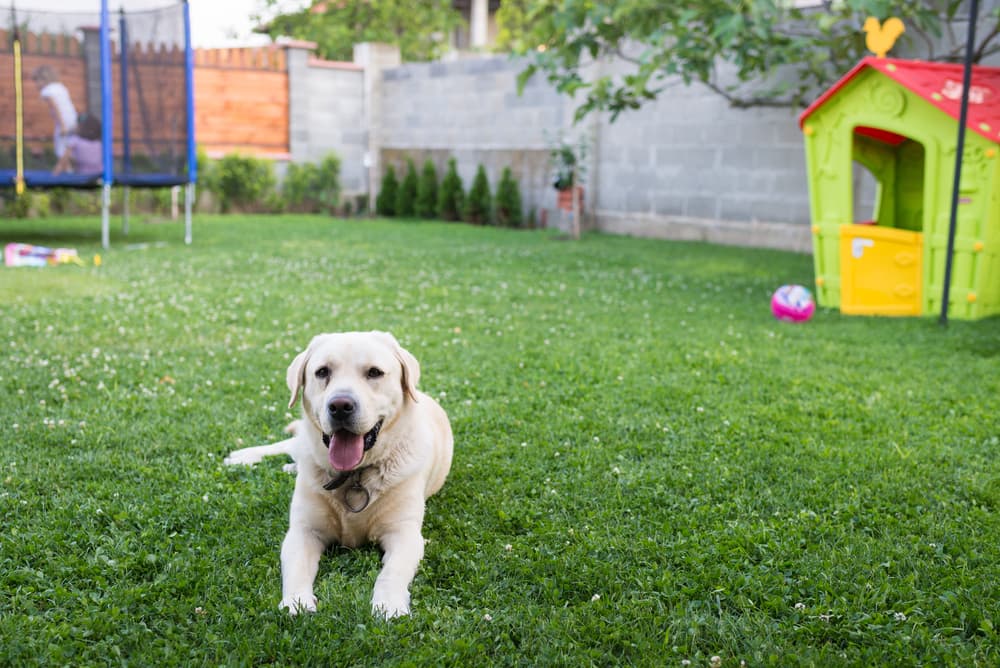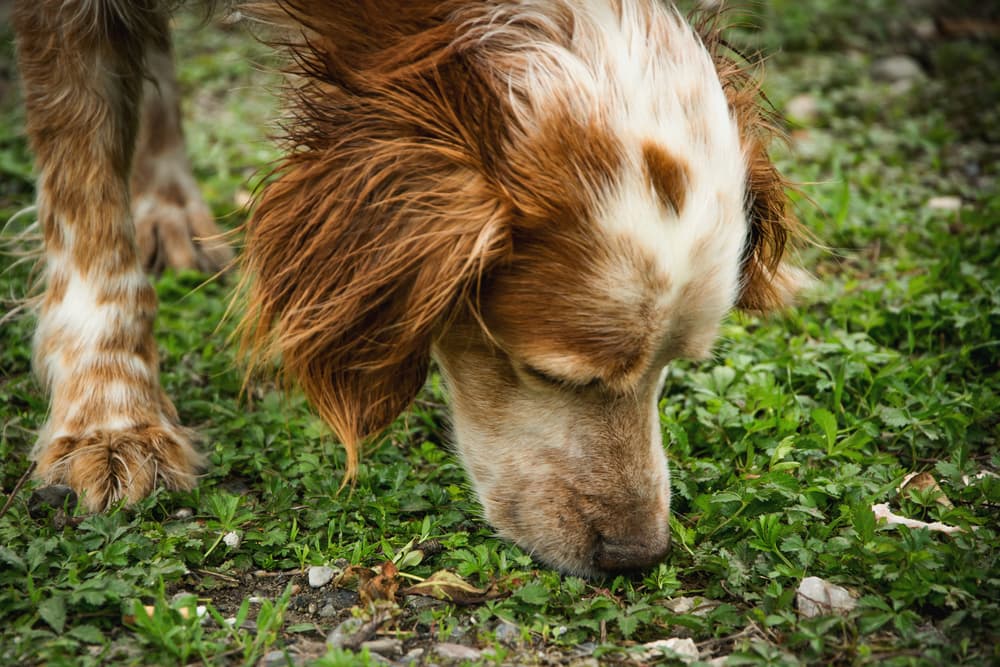
By Kate Hughes
Reviewed by Stephanie Liff, DVM

One of the foremost pleasures of being a pet parent is watching your dog frolic freely outdoors. But while fresh air, sunlight, and exercise are all good for your canine companion, your yard can also be home to some scary dog dangers.
Knowing about these backyard dangers for dogs, guarding against them, and—perhaps most important—having a solid plan in place for when your dog gets into something he shouldn’t, is key to keeping him safe and sound.
Backyard dangers for dogs vary greatly depending on where you live. If you live in a place where there are venomous snakes, for example, then this is likely the most dangerous environmental risk for your pet.
Invisible fences also leave dogs vulnerable, as they don’t prevent wildlife from entering your backyard or garden. Everything from coyotes and foxes to stray dogs can wander into a yard with an invisible fence.
While not all may apply to the region in which you live, here are nine of the top backyard dangers for dogs.
9 Backyard Dangers for Dogs
Toxic Plants

Toxic plants are one of the biggest dog dangers in your backyard. Many pet parents don’t realize that the plants surrounding their home could be poisonous. As such, the first line of defense is education. It’s helpful to learn how to identify common yard plants toxic to dogs.
Lily of the valley, foxglove, oleander, kalanchoe, and sago palm are among the backyard plants poisonous to dogs, but there are many others to watch out for. Other toxic plants and toxic weeds for dogs include aloe, daffodils, chrysanthemum, gladiolas, and peonies.
If you think your dog has ingested a toxic plant, get a sample or a photo of the plant to show your veterinarian. If your pet is already demonstrating clinical signs of toxicity, such as altered mental state, weakness, or vomiting, get them to the nearest veterinarian or emergency veterinary hospital immediately.
Fruit and Vegetable Gardens
Unfortunately, flowers and weeds aren’t the only type of greenery that pet parents need to look out for. Common garden fruit and vegetable plants can also be toxic to pets.
Ones to watch out for include tomato plants (leaves, stems, and unripe fruit) and rhubarb (leaves). Onions, garlic, and other members of the allium family are also toxic to dogs.
The ripe fruits are generally not a concern, it’s the greenery and seeds that can be toxic. Dogs and cats can suffer gastrointestinal upset, depression, and weakness if they ingest the wrong plant.
Again, if you suspect your furry friend ate something dangerous, you should contact animal poison control immediately.
Mushrooms

Not technically a plant, mushrooms can also be extremely dangerous for dogs. Pet parents should examine their yard once weekly, especially after heavy rains, to pull mushrooms.
Ensuring your yard has proper drainage will help limit the growth of mushrooms and other potentially dangerous fungi.
Wild Animals

Wild animals such as bears, coyotes, badgers, rats, squirrels, and even feral cats can be extremely dangerous to dogs if they meet face-to-face in your yard.
If you live in an area with dangerous indigenous wildlife, do not leave your pet unsupervised when he is outdoors. Most dangerous wildlife will stay away from people, so if you are with your dog, an animal will most likely not pursue him.
If your dog does have an altercation with a wild animal, do not put yourself at risk. Make sure you are safe and try to distract the animal by throwing an object like a bottle of water or book. Then attempt to remove your dog from the situation, if you can do so safely.
If your dog sustains any injuries, veterinarians recommend wrapping the wound with plastic wrap (not too tight), applying pressure to any areas that may be bleeding, and seeking emergency veterinary assistance.
Some animals, including raccoons, bats, foxes, and skunks, can also be a source of rabies—an important reminder to keep your pet’s vaccinations up to date. In addition, rodents and rabbits can spread tapeworms to dogs (more on this next) and can easily enter yards and gardens.
Worms

Keeping dogs parasite-free can be a challenge, and any dog that spends time outdoors is at risk. Dogs should be screened for parasites and treated for infestations during their annual checkups.
Among the parasites that dogs may encounter outdoors are several types of worms, including heartworm, hookworm, roundworm, tapeworm, and whipworm.
Dogs can be exposed to microscopic roundworm, hookworm or whipworm eggs in contaminated soil, tapeworm from infected rodents and rabbits in your yard or garden, and heartworm from infected mosquitoes.
Fortunately, there are preventive measures pet parents can take against worms, especially hard-to-eliminate ones like whipworms. Broad-spectrum parasite protection is an effective line of defense.
It’s a little gross, but here’s what pet parents need to know about each type of parasite:
Whipworms
Though they are one of the most common intestinal parasites in dogs, whipworms can be especially difficult to control (1). This is because their microscopic eggs, laid by the thousands, are especially hardy and can lay dormant in the soil for several years, which makes reinfection a likely outcome (2).
Heartworms
Have you ever been bitten by a mosquito in your yard? Your dog is also at risk. Transmitted by infected mosquitoes, heartworms take up residence in a dog’s pulmonary arteries and can grow up to a foot in length in over just a few months. A heartworm infestation can be fatal, so if your vet finds that your dog is carrying this parasite, he or she will initiate the appropriate treatment (1).
Hookworms
Hookworms are parasites that consume a large amount of blood and can cause bloody diarrhea, weight loss, and anemia. An infection can also lead to skin lesions on a dog’s paw pads (1). Severe infections can be fatal due to excessive blood loss. Larval hookworms in the environment can also penetrate human skin and cause infections in people, such as those who walk barefoot or play in contaminated soil.
Roundworms
Most pet parents are familiar with roundworms, as they are common and highly likely to be seen in puppies in their first few weeks with you. Roundworms can reach lengths of up to 15 cm in a dog’s small intestine (1).
Tapeworms
Dogs can contract several different species of tapeworms, either from ingesting infected fleas, small rodents, rabbits, livestock, or other wildlife. When a dog eats an intermediate host that is carrying tapeworm larvae, the larvae can grow into an adult tapeworms inside his intestine.
Ticks and Fleas
If your dog goes outside, chances are he will be exposed to ticks and fleas, which can carry disease. You can limit your dog’s risk of infestation with routine monthly prescription tick and flea medication.
Over-the-counter tick and flea products can cause problems if the dosage is incorrect or if it’s for the wrong species, so always use veterinarian-recommended products. Ask your veterinarian about a chewable tablet that protects against ticks and fleas.
If you find a tick attached to your dog after he goes outside, you should safely remove it. Place the tick in a sealable bag and schedule an appointment to bring it to your veterinarian.
Spiders, Stinging Insects & Snakes
Beyond ticks and fleas, spiders, stinging insects like bees and wasps, and snakes can also pose a risk to dogs in your yard.
Spiders and scorpions often find shelter in wood piles, so try to limit your dog’s access to them. Snakes may also hide under rocks, stacked firewood, sheds, bushes, and yard debris.
If you suspect your pet has been bitten by a snake, it’s an emergency that requires immediate veterinary attention. Pet parents will typically see the snake bite occur, or their pet will come in with an obvious bleeding wound with two to four punctures, indicating a bite in a region where snakes are prevalent.
Signs your dog may have been bitten or stung by animals or insects include limping, swelling, or licking at a specific area. If you suspect your pet may have been bitten or stung, monitor the site for swelling, bruising, or discharge over the course of 12 to 24 hours. If you notice any of these signs, take your dog to the veterinarian.
Poisons and Pesticides

While many pests pose a risk to dogs, chemical means of controlling those pests are also a concern. Keep anything toxic in a locked cabinet and resort to non-poison pest control methods—such as mouse traps—when possible. Pesticides and dogs are a dangerous combination. If your dog is exposed to pesticides, you should bring him to a veterinary clinic immediately.
Pools
Pools can pose a severe danger to pets, especially during the off-season. Make sure your pool is covered in cold weather and that older or frail pets are never out by the pool unsupervised.
REFERENCES:
- European Scientific Counsel Companion Animal Parasites. Worm Control in Dogs and Cats: ESCCAP Guideline 01 Third Edition – July 2017 [PDF file]. Retrieved from http://www.esccap.org/uploads/docs/0x0o7jda_ESCCAP_Guideline_01_Third_Edition_July_2017.pdf
- Trichuris Vulpis. Companion Animal Parasite Council. Retrieved from https://capcvet.org/guidelines/trichuris-vulpis/
© 2020 Elanco. EM-CA-20-0020
The post Is Your Yard Safe for Your Dog? appeared first on iHeartDogs.com.
from iHeartDogs.com https://ift.tt/3m8e8pc https://ift.tt/37tg4EP

No comments:
Post a Comment